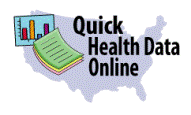Skip section navigation (navigation may have changed)
Section navigation
For Teachers and Educators

Quick Health Data How-To Guide
 Visit www.womenshealth.gov/quickhealthdata
Visit www.womenshealth.gov/quickhealthdata- Click on either Quick Health Data (QHD) Online or “Follow this link to get started”
- Go to “Click to start using Quick Health Data Online now”
- Begin the 1, 2, 3 data selection process below:
1. Select Variable
This page allows you to select data from the QHD database.
- Click on the data category desired (e.g., Demographics).
- Click on the down arrow next to the “Select One” window. A drop down list of all topic areas within the main category that you selected will appear. By clicking on a particular drop down sub-category, the full listing of data available will be shown.
- Select data component.You can select data components one by one by highlighting the component(s) then clicking on the “Add” button. You can select more than one component by clicking on the components(s) you are interested in while holding down the Control key. By clicking the “Advanced Search” box you can select specific gender, race, and year.
2. Select Geographies
This page allows you to select geographic areas to look at either by using the pale purple tabs towards the top of the page or by using the check boxes, found lower on the page. Remember to click on the “Add” button below the selection window.
- Tabs: You can click on one of the three purple tabs to select geographic areas. You can select by Geography (county, state, region and/or nation), by State, or by Region (DHHS regions).
- Check Boxes: You can also select all geographic units in a category by clicking on the boxes below the selection window. Using check boxes, you can select all counties (3,100+ counties), all states (includes DC and territories), all regions (10 DHHS regions) or the nation.
3. Generate Report
The Generate Report tab opens a new page with the data components and geographic areas that you selected displayed in a table. There are many options for viewing and exporting results:
- Charts: To view data in a chart format, click on the blue “View Charts” link on the top left of the page (below the OWH logo). Select chart type and labels.
- Maps: To view a map of data, click on the blue “View GIS Map” link on the top left ,of the page (below the OWH logo).
- Export: To export data, click on the down arrow on the “Select a Format” window on the top of the page, highlight the format desired, and then click on the “Export” button to the right of the window.
Note: Data are available at a range of geographic levels. When data within a sub-category is available only at the state level or higher (i.e., no county level data are available), the sub-category name is followed by “– State.”
Data descriptions: At any point in the selection process, a more detailed description of a data component can be seen by highlighting a variable of interest and clicking on the Details box to the right of the selection window. A description of the component will come up. Highlighting and clicking on the “Sources” box will give you information about the source of data component(s).
More detailed information about the system including an online tutorial can be found at: http://www.healthstatus2010.com/owh/help.html
QUICK EXAMPLE WALK THROUGH:
- From the Welcome page, click on the “Start System” link on the left navigation bar.
- Click on the Mortality tab within the Select Variable screen.
- Click on Death Rates, by Sex and Race, Age Adjusted.
- Choose the following variables and add them to Your Selections box:
- 2003 Total Death Rate (Age Adj)
- 2003 White Tot Death Rate (Age Adj)
- 2003 Black Tot Death Rate (Age Adj)
- Click on "Select Geographies."
- Click on the drop down box and select Maryland.
- Highlight Maryland, and all of the counties in Maryland, and add them to Your Selections box.
- Click on Generate Report.
- Note that the few blanks shown are because of suppression of small numbers to protect individual privacy.
- Click on View Charts. This provides a bar graph of the selected data.
- Click on View GIS Map.
- Leave the settings as they are, and click on "Click Here to Generate Maps."
- The resulting maps display the values for each of the selected variables for the state of Maryland.
- Note that tables, graphs and maps can be exported to other programs, such as Excel, or simply cut and pasted into your report or PowerPoint presentation.
![]() = This article, publication, web site, or organization is from the U.S. government.
= This article, publication, web site, or organization is from the U.S. government.
Content last updated August 12, 2007





